In summer, outdoor projectors get a lot of attention. If you are lucky enough to live in a semi-detached house or villa with a garden, you could set up your sessions with the neighbors. Or maybe next year you want to party when there is an important game or set up private cinema passes with friends, as a couple or maybe alone.
The common of all these situations is that you are going to need an outdoor projector along with a screen, or by default, a white wall or something similar.
Now, what projector should I choose? The most expensive? What should I notice when I go to the store or read a catalog? Which one best suits my needs?
With the following guide, which we will complete with a selection of best outdoor projectors of various prices and features, we want to help you choose what is probably an essential purchase at home.
What is a Projector?
Table of Contents
A Projector is a device aimed to generate an image from a video source or Blu-ray player and project it as authentically as imaginable against a projector screen or other flat surface. For example, you might use a projector to display a presentation on a big screen so everybody in the room can see it. It can also show video and animated images.
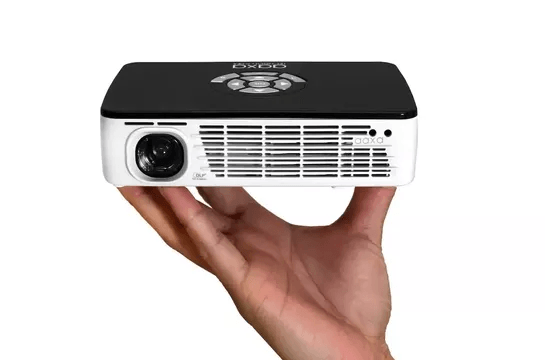
The projection is made from a special lamp. In recent years, the use of the device is out of the office context. Indeed, the video projector can today be used as a home theatre, replacing the TV. It is much cheaper and technological advances have allowed it to offer a very satisfactory image quality with full HD and 3D support for some models.
Unlike the TV, the projector can be used outdoors, in a garden or during an outdoor movie night. It is also transported very quickly, the device is in principle lightweight and small. It should be noted that this type of device is used in a dark place if you want to optimize the quality of projection. Models with high-brightness lamps can be used in bright spots, but colors and images will always be less bright.
Usually, the outdoor projector is connected to a computer. More recently, connectivity has changed a lot. Thus, modern models can be linked to many devices such as televisions, game consoles, smartphones, and tablets or even USB sticks. There are even models with wireless connection via Bluetooth or Wifi. These connected projectors provide access to streaming platforms and can, therefore, watch movies and videos online without going through a computer or a smartphone.
Also Read: best hd projector under 500
When was the first projector invented?
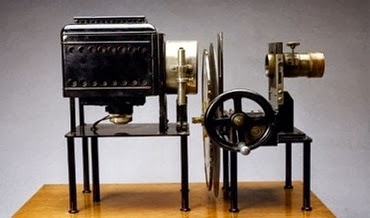 The first projection concept was brought by the German Pastor named Athanasius Kircher in 1664. He projects the hand-painted image with the help of oil lamp against a blank white screen; then his concept shaped the origin for the other people to develop a device which was known as a “projector”.
The first projection concept was brought by the German Pastor named Athanasius Kircher in 1664. He projects the hand-painted image with the help of oil lamp against a blank white screen; then his concept shaped the origin for the other people to develop a device which was known as a “projector”.
What is outdoor Projector?
The outdoor projector also called outside or daylight projector, which has the brightest lamp (3200 or more lumens) to project the bright image even in daylight.
How outdoor Projector works
Different technologies are used for the manufacture of video projectors. Whatever the type of technology, the operating principle remains the same. Information is sent by a peripheral device (computer, smartphones, USB) connected to the outdoor projector.
The player of the device will decode the files. The lamp placed in the projection screen will then display the images or videos of the player. These images are projected on an interactive screen, a wall or a generally clear white vertical surface. An outdoor projector is always equipped with a fan whose role is to cool the device. It can also be equipped with speakers that emit sound files for playback.
Also Read: Best Projector under $1000
How a projector used today?
Types of Outdoor Projectors
The projectors are generally classified according to their main function: home theatre, professional applications or portability, and 3D projectors. These types of projectors have distinct features that make them ideal in the situations for which they are designed.
1. Business Projectors
 Mostly used for business or school presentations in a variety of environments, video projectors have the features you’ll need to get clear projections to keep your audience enthralled.
Mostly used for business or school presentations in a variety of environments, video projectors have the features you’ll need to get clear projections to keep your audience enthralled.
What are the characteristics of a business projector?
a. Brightness
A video projector should be powerful enough to project clearly into partially or fully lit rooms. The brightness is measured in lumens. Choose a model with a minimum brightness of at least 2,000 lumens to ensure that your images are projected clearly, especially in very large rooms.
b. Ease of use
when you are often in conference rooms, it is essential to have a quick model to install and turn off. Find a model that includes a quick start and stop, as well as an automatic shutdown feature so you can leave the room in no time.
c. Portability
if you’re planning to travel a lot, you’ll be happy to know that most projectors are lightweight and compact, so you can easily carry them around. Discover the pocket projectors below.
d. Connectivity
In most cases, you will prepare your presentation on your computer or laptop and you will transfer this content from an external device. Most video projectors are equipped with a VGA or USB port, which makes it easy to connect them to your computer or USB key. However, some models also include HDMI and DVI inputs to help you expand your options. Naturally, the more connection options you have, the more freedom you will have.
2. Home Theater Projectors
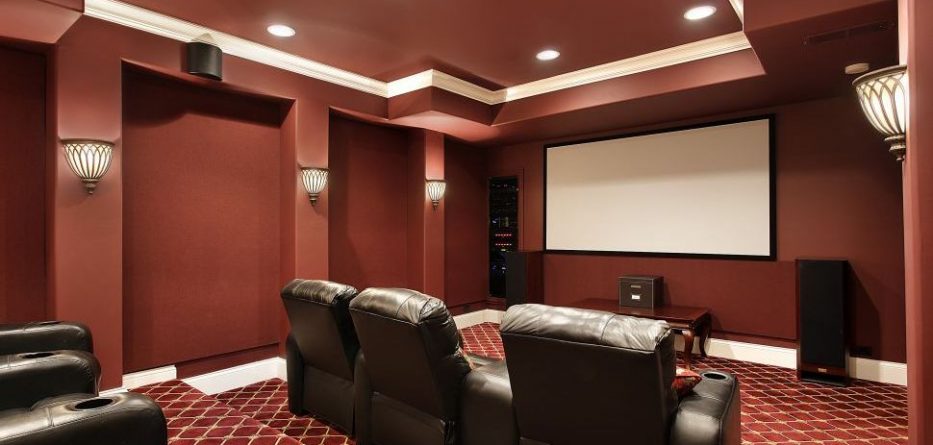 To enhance your home entertainment setup, add an outdoor projector and screen – you’ll enjoy movies, games and online content just like you’re in the movies. Home theater projectors focus on many of the features you can find on an HDTV’s feature sheet, making them ideal for home entertainment. Especially:
To enhance your home entertainment setup, add an outdoor projector and screen – you’ll enjoy movies, games and online content just like you’re in the movies. Home theater projectors focus on many of the features you can find on an HDTV’s feature sheet, making them ideal for home entertainment. Especially:
a. Resolution
For the best possible image projection, it is advisable to opt for a home theater projector with a resolution of at least 720p. However, a full 1080p HD projector will give you the best possible image quality of your Blu-ray player, high-definition gaming console, and other high-resolution devices.
b. Contrast Ratio
A high contrast ratio will bring out all the hidden details in shadows and bright scenes with incredible clarity. In addition, each generated image will be detailed and vibrant with precise colors.
c. Projection Ratio
Calculated by dividing the distance between the lens of your projector and the screen by the width of the image you want to project, the projection ratio will help you choose the optimal distance for your home theater.
d. Connectivity
The most important connection with your home theater projector will be the HDMI input; the more you have, the more you can connect to high definition sources. Some models also include component video, VGA and USB inputs for even more options.
Also Learn : Tip to build Home Theater Room
3. Pocket projectors – Mini portable Projector
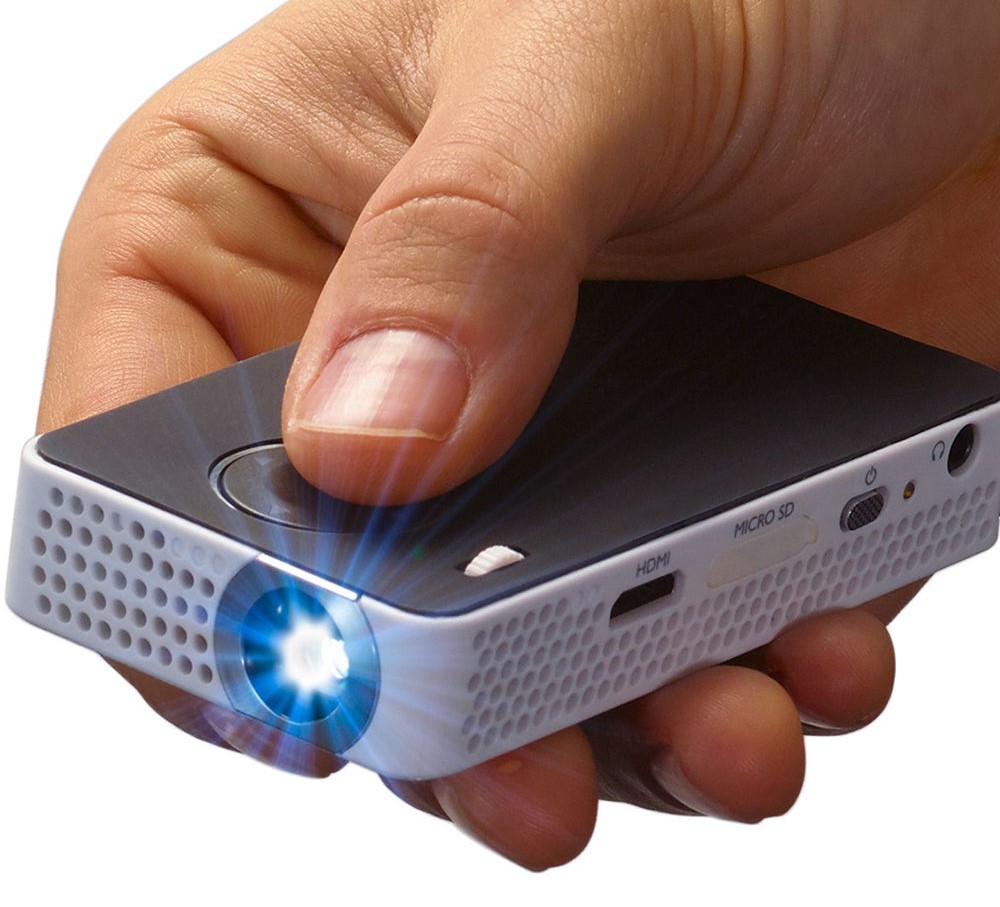 Designed to fit in your pocket or purse, pico projector spotlights are the ideal choice for people who are often on the move. Whether you’re doing business presentations or enjoying your entertainment with your friends, these powerful, compact projectors can project panoramic images up to 70 inches. In addition, they have an LED light source that can last more than 20,000 hours, which is five times longer than a typical LCD projector. You will really enjoy your entertainment for a very long time.
Designed to fit in your pocket or purse, pico projector spotlights are the ideal choice for people who are often on the move. Whether you’re doing business presentations or enjoying your entertainment with your friends, these powerful, compact projectors can project panoramic images up to 70 inches. In addition, they have an LED light source that can last more than 20,000 hours, which is five times longer than a typical LCD projector. You will really enjoy your entertainment for a very long time.
a. Brightness
Although they are not too bright, the Pico LED lamps to produce between 20 and 1,000 lumens, which is enough to make a presentation in front of a small group. The brightness and battery life are constantly improving, and some models have a long battery life to avoid having to replace bulbs.
b. Connectivity
Because they are designed to be versatile, they are easy to use and ready to use, and they typically have the Wi-Fi capability to access content from the cloud or to stream media without the need for cables. Connect these small devices to any compatible mobile media player, such as a laptop, smartphone or camera, to project large images that your audience can fully appreciate.
4. 3D projectors
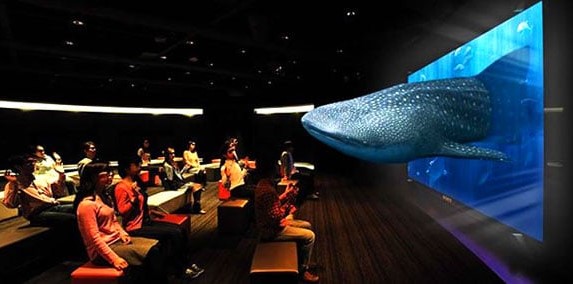 3D projectors are the ideal solution for an exceptional cinematic experience. Most models are generally equipped with high-end features and advanced features. They are therefore perfect for enjoying the 2D content as well. Remember: to enjoy 3D content, you’ll need other 3D-compatible devices like a 3D Blu-ray player and 3D glasses.
3D projectors are the ideal solution for an exceptional cinematic experience. Most models are generally equipped with high-end features and advanced features. They are therefore perfect for enjoying the 2D content as well. Remember: to enjoy 3D content, you’ll need other 3D-compatible devices like a 3D Blu-ray player and 3D glasses.
5. Gaming Projectors
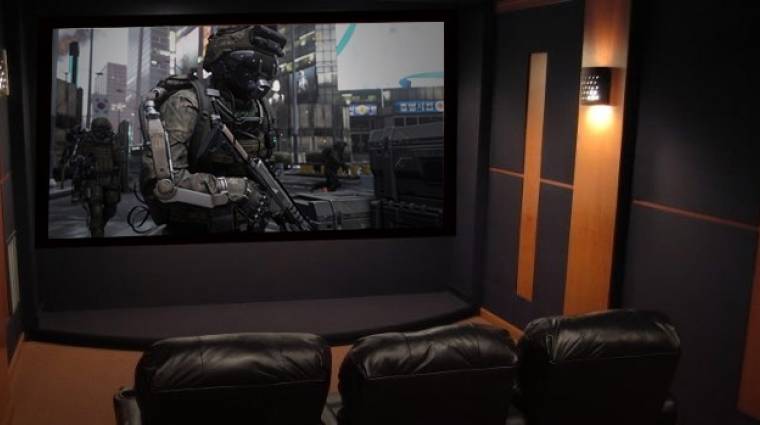 With the current high, constantly increasing quality of game consoles and games, the technical requirements for gaming projectors have increased considerably. Comparable are premium gaming projectors with high-priced home cinema projectors, where the games beamer in terms of light intensity, contrast and refresh rate sometimes even higher demands. In any case, playing HD quality is not much fun and 3D capability increases the enjoyment of playing in classes.
With the current high, constantly increasing quality of game consoles and games, the technical requirements for gaming projectors have increased considerably. Comparable are premium gaming projectors with high-priced home cinema projectors, where the games beamer in terms of light intensity, contrast and refresh rate sometimes even higher demands. In any case, playing HD quality is not much fun and 3D capability increases the enjoyment of playing in classes.
Gaming projectors are essentially DLP projectors. These are advantageous because of their response times compared to the classic LCD projectors. In addition, they have a higher tolerance for daylight and are quite quiet. Current device types have largely reduced the typical problems of the DLP projectors: There are energy-saving models, yellowing is a thing of the past, and even rainbows hardly ever appear. Modern devices also score with variable connections, HD, and Full HD. Good and expensive devices convince with the long service life of their wearing parts.
- The luminous intensity of at least 3000 ANSI lumens and more even for bright rooms
- High resolution from 1080p
- Contrast 100,000: 1 or more is ideal, at least 5000: 1
- Image refresh rate from 120 Hz, an ideal is 480 Hz
- HD, better Full HD should be
- Gaming projectors can be an expensive toy that is oversized in rare use
- High power consumption
- Lenses and lamps are wearing parts – the life of both parts can vary from device to device
6. DVD Projectors
 The concept of DVD projector is interesting for a home theater projector. The projector comes with an integrated DVD player in it is called DVD projector. The 2.1 sound system can still be found in the case make it is slightly a bulky device.
The concept of DVD projector is interesting for a home theater projector. The projector comes with an integrated DVD player in it is called DVD projector. The 2.1 sound system can still be found in the case make it is slightly a bulky device.
7. HDMI Projectors
HDMI projectors are the most popular projectors at the moment. Because this interface not only transmits image signals but also audio signals, as well as control signals, all in digital quality. So you can assume that an HDMI projector delivers the pretty best picture result, as an analog projector. Also, the resolution is correspondingly finer and higher, so that the entire picture is reproduced sharply. The connection and handling are much easier, even for inexperienced users.
Multi-purpose projectors
Different types of Technology used in outdoor projectors/strong>
There are mainly three types of video projectors. The distinction between these different types is based on the projection technology used by each device. Some models use LCD technology while others embed a DLP projection. There have also been SXRD projectors for a few years. Each type of video projectors has its advantages and disadvantages that we invite you to discover.
LCD Technology
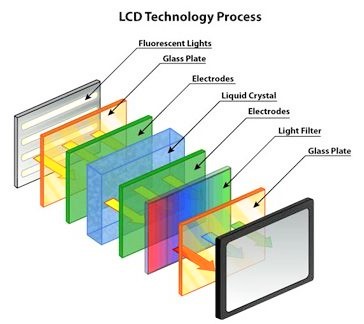 LCD projectors are based on the principle of LCD (Liquid Crystal Display). Created in the early 1990s, this type of projector diffuses images on the principle of polarization. To create the images, the device is therefore equipped with polarizing filters in liquid crystal through which the light emitted by a metal vapor lamp passes. These filters individually intercept the pixels to form the images. The first LCD models had a single panel.
LCD projectors are based on the principle of LCD (Liquid Crystal Display). Created in the early 1990s, this type of projector diffuses images on the principle of polarization. To create the images, the device is therefore equipped with polarizing filters in liquid crystal through which the light emitted by a metal vapor lamp passes. These filters individually intercept the pixels to form the images. The first LCD models had a single panel.
Later, this type of mono-LCD projectors was replaced by tri-LCD technology. The principle is the same, but the latter uses three liquid crystal panels red, green and blue. This technology provides better resolution of images with a palette of more than 16 million pixels. Tri-LCD projectors are price-level and offer clear, bright and stable images. On the other hand, these images will lack contrast and black is not always much highlighted. In addition, pixels can be visible when viewing the screen closely.
- Superior brightness and color saturation in rooms with a lot of ambient light
- Sharper images for data applications (spreadsheets, text, static charts)
- Consume less electricity
- Generate less heat
- Slightly quieter than DLP projectors because they have fewer moving parts
- The separation of the pixels is much more visible; it produces a “toasting” effect on some images.
- Larger and heavier than some DLP projectors
- Blacks may appear “washed out”
- Lower general contrast
DLP Technology
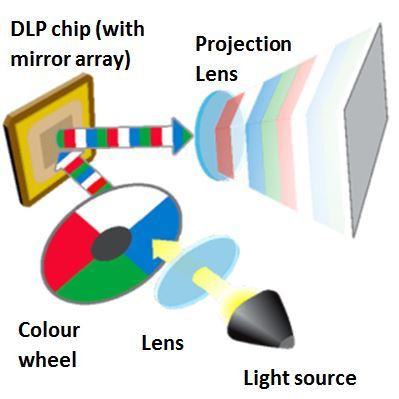 The first DLP (Digital Light Processing) projectors were offered to the general public in 1996. This so-called reflective technology projects in two stages. The beams of light are, at first, broken down into three colors (red, green, blue) by a filter. A set of micromirrors will vary the brightness depending on the desired color. The beams, set in color and brightness to form the pixels, will finally cross a lens to project the images. DLP projectors are appreciated for the virtual invisibility of the pixels and for the good brightness. Black is also much deeper and the contrast is good. However, we sometimes see the rainbow effect with this type of projectors which also costs more than the Tri-LCD models.
The first DLP (Digital Light Processing) projectors were offered to the general public in 1996. This so-called reflective technology projects in two stages. The beams of light are, at first, broken down into three colors (red, green, blue) by a filter. A set of micromirrors will vary the brightness depending on the desired color. The beams, set in color and brightness to form the pixels, will finally cross a lens to project the images. DLP projectors are appreciated for the virtual invisibility of the pixels and for the good brightness. Black is also much deeper and the contrast is good. However, we sometimes see the rainbow effect with this type of projectors which also costs more than the Tri-LCD models.
- The higher frame rate for smoother images
- More compact and lighter than LCD projectors with similar characteristic
- Pixels blend together perfectly for a consistent image (more essential for home theater applications)
- More cinematic quality images from DVD, Blu-ray players, and HD source
- Blacks deeper and more realistic than blacks produced by LCDs
- Higher overall contrast
- The “rainbow” effect is only visible to some people, but it may be embarrassing.
- More moving parts and higher power consumption than ACL models
- The color filter disc used in the light source can generate a soft but audible sound
- Color saturation lower than LCD models, especially with fully illuminated reds and yellows
- When ambient lighting is important, requires about 30% more lumens to achieve the color richness that is similar to that of LCD models
SXRD Technology
Developed in the late 2000s, SXRD projectors are the most interesting in terms of image quality. They operate on the basis of Liquid Crystal on Silicon (LCOS) technology which is a derivative of LCD. The LCD arrays are placed on a reflective surface. The combination of reflective and transmissive technologies brings a better result. The level of brightness is higher than those of other types of projectors and there is no grid on the images. This SXRD technology is used on high-end 3D or 4K video projectors. Their only drawback will be their price, often very high compared to those of tri-LCD or DLP models.
How to choose your projector Buyer’s Guide
Now that you know the types of devices you could choose from, you will need to purchase a video projector. To choose the right model, consider:
Your Budget
When you are going to buy a projector a question “How Much Does an Outdoor Projector Cost?” arises in your mind. The answer is quite straightforward, the prices of the projectors depend not only on the type of projection technology used but also on several other criteria such as the range, the image quality, and the features.
A DLP model can, therefore, be cheaper than a tri-LCD model according to their technical characteristics. In general, you could buy an entry-level model from $95. High-end models can cost up to 3500$.
The use of the Outdoor Projector
For small, less demanding performances, it will not be necessary to purchase a high-performance model. On the other hand, if you intend to offer a home theater, choose those that provide excellent picture quality with a 3D option if necessary. You may also use the unit outdoors or in bright places (in an office or conference room). It will then be necessary to find the model which answers to its constraints of use.
What are the essential criteria before buying?
Also, consider the technical characteristics of each model when choosing your projector. Here are the most important criteria:
Resolution
The resolution is the number of pixels counted horizontally by the number of pixels counted vertically (length x width) to form a rectangular grid. Ideally, the more pixels you have, the clearer, sharper, and more detailed the image. Prefer models that have high definition quality, 4K or 3D especially if you want a home theater.
Two features represent the resolution:
- The native resolution is considered the true resolution of the projector. It is the number of actual pixels in the image processing chip.
- The maximum resolution is the highest resolution that a projector can support. For this purpose, it widens or compresses the native pixels numerically. It is recommended to focus on the native resolution because the maximum resolution may have distortions and visual artifacts the larger the projected image.
Keystone Correction
Moving the lens
By moving the lens, horizontal compensation is performed mechanically by physically moving the lens sideways or adjusting its orientation.
Projection report
The projection report will help you determine how far you need to place your projector from the screen. This is usually in terms of the projection distance per foot of image width. For example, a projection ratio of 2: 1 represents 2 feet of projection distance per foot of screen width. So if you want an 84 "(or 7 ') wide image, you need to place the projector at 14 feet (7 feet x 2) from the screen.
Many projectors offer limited zoom for a projection ratio range. So you can make minor adjustments after attaching your projector.
Contrast:
This ratio represents the relative difference in brightness between the brightest and darkest pixels of a projector when viewed at the same time. High Contrast Ratio Home Theater Projectors provide highly detailed images for your movies, TV shows, and video games. Video projectors are less focused on the contrast ratio. They focus more on the number of lumens.
In principle, high contrast means better black depth. A minimum contrast of 10,000: 1 is required for good color sharpness.

Brightness:
It takes at least 1000 lumens to have excellent brightness. Favor models with a high level of intensity (up to 3200 lumens) for better viewing comfort.
Connectivity:
A model presenting only a VGA input is not impressive. Choose those with extensive connectivity (USB, AV, HDMI, audio), and that can be used with many devices. Models with Wi-Fi and Bluetooth also offer a broader scope of use.
The sound level:
The fan is often quite noisy on a video projector. The sound level of thirty decibels is acceptable, beyond this threshold, noises can be disturbing.
The life of the lamp:
the lamp is considered a consumable. He replaces himself regularly. To avoid additional expenses, choose models with long life lamps (over 10,000 hours).
You will need these Outdoor Projector Accessories
Projection Screens
In general, you can project an image on any flat surface, but for best results, it is advisable to invest in a projection screen. They come in a variety of sizes, and you can choose a screen that you can hang from the ceiling or a model that rests on a tripod.
Replacement bulbs
Most projectors have a lamp with a lifespan of a few thousand hours. After that, you will need a spare lamp to continue making your presentations and entertain yourself.
Wall Mounts
The stands are the ideal choice for fixed installations such as home theatres, classrooms or meeting rooms. When the projector is hanging from the ceiling, you do not need to install it every time.
Cables
Depending on the inputs your projector is equipped with, it may also be advisable to purchase HDMI, component, USB, VGA and other wires for a variety of connectivity options.
Networking
Projectors with an Ethernet port or wireless connectivity allow you to connect to an existing network. This capability allows you to stream content from the Internet or your compatible devices connected to the network, such as a hard disk or computer.
Best Outdoor Projectors Brands
With the exception of some more specialized brands like Benq or Optoma, we find the big names of electronics among the manufacturers of projectors. As to which brand to choose, it depends on your budget and your needs, manufacturers usually offering several product lines (home theater, office, short focal, LED, 4K, etc).
- Benq
- Optoma
- Epson
- Acer
- Sony
- LG
- JVC
- View Sonic
Benq
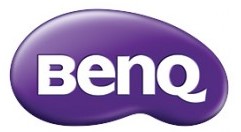 The brand is a reference for mid-range home theater projectors. Quasi-only DLP, Benq models hold the first place in many tests and comparisons, especially with the bestseller W1090 and previously the W1070 and W1070 +.
The brand is a reference for mid-range home theater projectors. Quasi-only DLP, Benq models hold the first place in many tests and comparisons, especially with the bestseller W1090 and previously the W1070 and W1070 +.
The manufacturer offers video projectors for professionals and individuals. To better identify them, the names of the models for the house (movies, hobbies, etc.) begin with the letter "W".
Optoma
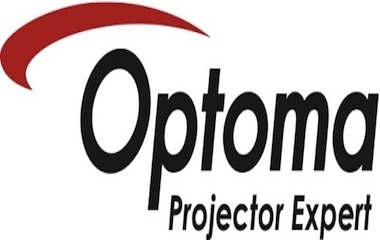 Specialized in video projection and related equipment (screen, audio, etc.), Optoma offers one of the broadest range of LED and DLP projectors for both individuals and businesses. You will find many small and medium-sized models in different categories: home, office, nomadic, ultra-light, and short focal, etc.
Specialized in video projection and related equipment (screen, audio, etc.), Optoma offers one of the broadest range of LED and DLP projectors for both individuals and businesses. You will find many small and medium-sized models in different categories: home, office, nomadic, ultra-light, and short focal, etc.
The name of home projectors usually starts with:
- GT: Short throw video projector (GT5500 +)
- H: HD ready video projector (H183X)
- HD : full HD video projector / 1920 x 1080 (HD142X, HD26
- UHD : UHD / 4K video projector (UHD550X, UHD60)
Epson
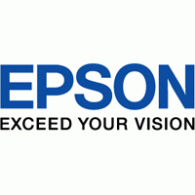 The world's No. 1 manufacturer of video projectors, Epson stands out from its competitors by offering only LCD models. The manufacturer is indeed the owner of the 3LCD technology that equips its products. The range is very complete, from small office projectors to 4K home cinema projectors.
The world's No. 1 manufacturer of video projectors, Epson stands out from its competitors by offering only LCD models. The manufacturer is indeed the owner of the 3LCD technology that equips its products. The range is very complete, from small office projectors to 4K home cinema projectors.
If the majority of its catalogue is oriented for the pro or institutional, Epson also offers a dedicated home theatre range: the models are identified by the prefix "EH": EH-TW5300, EH-TW9300. The projectors intended for business use have the prefix "EB".
Acer:
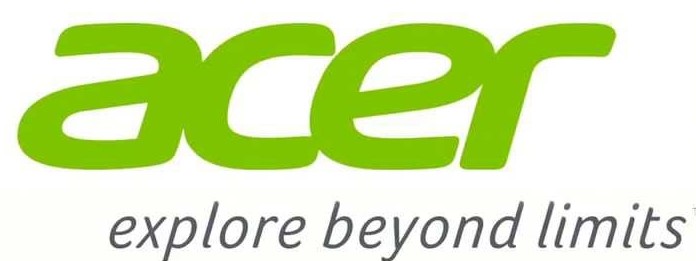 The computer giant also markets office, home theatre, and gaming projectors. Without being a reference brand in video projection, Acer still offers a large number of models for all budgets, from mini-mobile projectors to Ultra HD models.
The computer giant also markets office, home theatre, and gaming projectors. Without being a reference brand in video projection, Acer still offers a large number of models for all budgets, from mini-mobile projectors to Ultra HD models.
Sony
 The Japanese manufacturer mainly offers two types of projectors: a wide choice of business models (business, teaching, installation, etc.) and a more limited supply of top-of-the-range home cinema models. They use SXRD technology and are known for their image quality. However, they are relatively expensive projectors.
The Japanese manufacturer mainly offers two types of projectors: a wide choice of business models (business, teaching, installation, etc.) and a more limited supply of top-of-the-range home cinema models. They use SXRD technology and are known for their image quality. However, they are relatively expensive projectors.
Sony home theatre projectors are identifiable by name: HD models start with "VPL-HW" while 4K models start with "VPL-VW".
LG
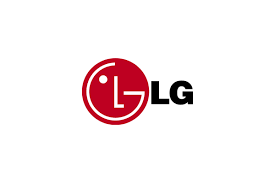 LG offers a small catalogue of compact LED or laser projectors. Generally intended for mobile use, the models are often very light with a design that stands out from that of its competitors.
LG offers a small catalogue of compact LED or laser projectors. Generally intended for mobile use, the models are often very light with a design that stands out from that of its competitors.
Because of the technology used (LED lamps), the projectors of the brand are mostly not very bright.
JVC
 Specialized in high-end home cinema projectors, JVC stands out from its competitors by offering a limited but very qualitative product catalogue. The technology used is mainly D-ILA (LCOS by JVC), which allows an exceptional image quality but at relatively high rates.
Specialized in high-end home cinema projectors, JVC stands out from its competitors by offering a limited but very qualitative product catalogue. The technology used is mainly D-ILA (LCOS by JVC), which allows an exceptional image quality but at relatively high rates.
View Sonic
Other brands
It is usually advisable, if your budget allows, to choose a projector of a known brand. It is often a guarantee of reliability and superior quality.
If you are looking for a cheaper projector, however, you can find a lot of "alternative" brands, with models at low prices but often inferior performance. If you choose a brand unknown projector, remember to read carefully the product description, which is sometimes misleading (a model presented as HD, for example, is only compatible HD).
How do I connect the projector and the source?
With a large number of ports that are available to you to connect your Projector with your source, you can quickly lose track. To bring order to the cable clutter, we would like to explain below the meaning and function of all connections and explain which connection you need for which resolution. What you should pay attention, to be able to enjoy the full projection pleasure. Let follow the guide;
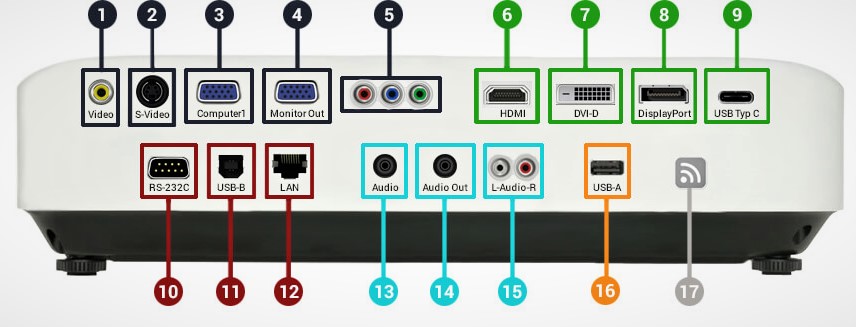
Analog video connections
Analog video and PC interfaces have been used for many years. Due to the lower data transfer rate, they now offer less good image quality compared to digital connections but are still widely used.
| RCA Video |
The cinch video connection is also called composite connection. For better visibility, it is usually sheathed in yellow. Since the transmission is only via one channel, the image quality is at a low level. |
|
| S-Video | The S-Video connection is also called S-VHS or Hosiden connection. Compared to the RCA video connection, it works with two channels (brightness/ colour). Qualitatively he is a bit better than the RCA video, but there are also limitations. These can be explained by the susceptibility of the signal, which is reflected for example in image disturbances. | |
 |
VGA |
The VGA connector is a 15-pin connector for image transmission on an analogue basis. It is also called DSub15 and is often found on notebooks and PCs. Compared with the other analogue connectors, it offers excellent picture quality. It can be screwed to the input or output device, and with a suitable configuration, it can be adapted to YUV. |
 |
VGA out | The VGA out connector allows looping of the VGA input signal through the projector. Thus, for example, a monitor can be connected to the projector to monitor the content displayed on the projector. Again, a screw of the connector is possible. |
 |
YUV | The YUV connector also called Y Cb / Pb Cr / Pr or Component Connector, is an analogue video connector with three channels (luminous intensity and two colour channels). Qualitatively he is the best analogue video connection. |
Digital video connections
At present, digital connections offer the best quality in image transmission because they operate with much more transmission channels than analogue connections. Especially for HD material, a digital connection is a prerequisite.
 |
HDMI |
Digital connection for the transmission of picture & sound. Necessary for high-resolution picture quality (HDTV). Since HDMI 1.4 (High Speed) suitable for the transmission of 3D content in Full HD. |
 |
DVI |
|
 |
DisplayPort | The digital DisplayPort connector is similar to the HDMI connector. It is used to transfer digital image and audio data. Unlike the HDMI port, this is royalty-free. From the DisplayPort Standard 1.3, a transfer of 5K material is already possible. The 1.4 standard is capable of broadcasting HDR10 and Rec. 2022, which plays an important role in 4K video projectors and 4K home theater TVs. Another advantage of the DisplayPort is that the plug has a snap-in nose that protects the plug from accidentally pulling out. |
 |
USB type C | The USB-C connector (also called Thunderbolt 3) is now the standard connector for many devices. It combines data, power and image transmission in one connection. It works with a data throughput of up to 10 gigabit / s. This makes it much faster than a conventional USB 3.0 port. It can be assumed that in some years it will replace the HDMI connection if necessary. |
Control Connections
Control connections are used for signal transmission of control signals. They are mainly used in fixed installations, where you need to control the device itself remotely or not reached with the standard remote control.
 |
RS-232 | Control signals can be transmitted to the projector via the RS232 connection, e.g. to switch it on and off. At first glance, the connection looks similar to a D-Sub interface. However, it is also available in round, as RS232C port. |
| USB Type B | The USB Type B connector is mainly used for the transmission of control data. This one allows the control of presentations or similar. Via the remote control of the Projector. The signal is then looped through the projector to the PC. | |
| LAN | The LAN connection is usually designed for the transmission of control data and more and more triggers the RS232 or RS232C connection as a control interface. On some devices, it also offers the possibility of data transmission, while it has a lower quality than the transmission quality of an HDMI, DVI or VGA connection. |
Audio Connections
Audio connections provide the option of routing audio signals to the Projector to use its integrated loudspeaker. Also, with audio outputs, it is possible to grind the signal through the projector. The audio connections are in most cases in analogue form.
| 3.5 mm jack IN | The 3.5mm jack (input) allows devices with internal speakers to send and output a sound signal from an external source to the device. This connection is also called a mini jack. | |
| 3.5 mm jack OUT | The 3.5mm jack (output) provides the ability to loop a sound signal through the projector through a 3.5mm jack input. This is used, for example, when installing external speakers in the vicinity of the projector. | |
 |
Stereo cinch | The stereo cinch connection offers the possibility to send a sound signal to the projector with projectors with an integrated loudspeaker. Compared to the 3.5 mm jack, the stereo RCA cables provide the advantage of better transmission quality over longer distances. |
Data Connections
The data connection is the classic USB type A interface since the Projector can directly play media from data carriers. However, it should be noted that the formats that can be played vary widely depending on the projector.
| USB Type A | The USB Type A port is usually used for external storage media such as USB sticks to play content through the projector. The majority of the projectors in this case, however, only able to play image files in JPEG format. Occasionally one finds also devices, which can play video files or Microsoft Office formats additionally. |
Wireless Transmission
In addition to the transmission of image signals by cable is increasingly resorting to a wireless data transmission. In most cases, this is a Wi-Fi connection. For this purpose, a receiver is mounted in the projector or on the projector and then addressed by a wireless network transmitter, which is located in the notebook, for example. However, it should be noted that the WLAN connection with projectors in the normal case does not reach the strength, how one knows her from the usual Internet connection ago.
 |
Wireless Internet Access | Via Wi-Fi, images, text, and presentations can be transmitted using the devices provided for this purpose. Due to the previously limited Wi-Fi strength of projectors, the transmission of moving images is restricted or not possible. Exceptions can be found only in home theatre equipment with appropriate equipment. With some projectors, it is also possible to play data via WLAN via apps from Apple devices (iPad / iPhone). |
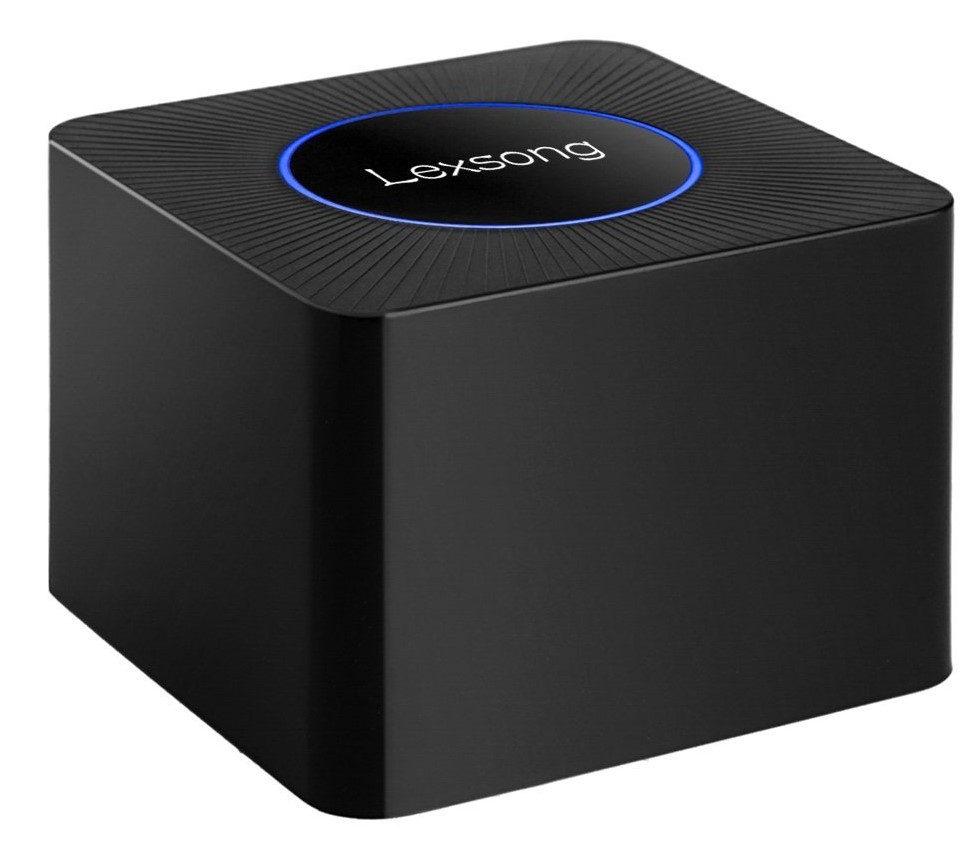 |
Miracast | In addition to conventional WLAN, Miracast, also known as screenshare or screen mirroring, is gaining more and more importance. This technology provides the ability to establish a point-to-point connection from a Miracast-enabled smartphone or tablet. The Miracast standard can be found in systems such as Android (from version 4.2) or Windows (from version 8.1). The transmission, in contrast to WLAN, is able to transmit a moving 1080p image signal in good quality. This makes Miracast suitable for transferring movies from a tablet or smartphone. Miracast itself can be found in projectors or integrated into external receivers (eg HDMI dongle). |
Conclusion
You could now choose much more efficiently the projector that will serve you in the office, and that will help home theatre at home. Refer to our opinion projectors to make the best choice and buy the right model at the best price.
